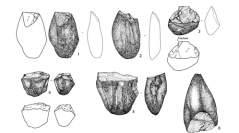

 Comptes Rendus Palevol
13 (2) - Pages 109-120
Comptes Rendus Palevol
13 (2) - Pages 109-120The study of prehistoric sites with lithic remains indicates that the occupation of continental Asia, notably India and China, seems to have taken place earlier than previously thought. However, this Early Pleistocene human dispersal out of Africa remains debatable for the Southeast of Asia, in spite of the discovery of original lithic assemblages on the Mekong terraces dated to the very beginning of the Middle Pleistocene in the centre of Cambodia, by Saurin and Carbonnel in the 1960-1970s. Although this fundamental lithic material has become a reference, it has not been subjected to renewed study of these artefacts over the past decades, and it is thus not possible, for the moment, to attribute it with certainty to a particular culture. In this paper, we present an analysis of the raw materials and a techno-typological study of a similar series of prehistoric tools gathered by one of us in order to bring to light new elements concerning the first Palaeolithic occupation of this region of the world.
Southeast Asia, Prehistory, Cobble tools, Ancient Palaeolithic